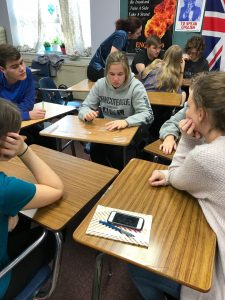Raoul Peck, in the introduction of the companion text to his documentary I Am Not Your Negro, said that receiving James Baldwin’s unfinished manuscript was like accepting “…a large jar filled with unlabeled pieces of a precious mosaic. Each piece, a promising diamond” (xvii). I wondered what students would do and could do if they received some of these words.
I used this activity as an introduction to the documentary and as an opportunity to play with words. Collecting approximately 75 words from the piece, I typed them up and cut them into individual strips. Scrambling the words, I made random collections of 15 words for students to grapple with. These words alone were fairly basic on their own–combinations created power and meaning. Students needed time to play with the words and experiment. I did not require anything to be written the first time we manipulated the word order. Most everyone has a smart device and could capture their work in a photograph as a means of recording it. This process allowed students to act in the moment and not overthink it before making the writing more permanent by putting it on the page.
We ultimately wrote two free verse poems inspired by and using most of the same words. One version was completely student driven and improvised, growing out of the group’s initial word associations, discussions, and compromises. At first, students organized the words based on word associations–what made sense together. Sometimes words just didn’t fit together. There was a mercy in this. I wanted to push students beyond simple combinations; I wanted for us to be surprised by unlikely combinations. What made them uncomfortable about these combinations? What sense could we make of how we felt when two contrasting words met? For example, one group was left with two words: murder and beautiful. I encouraged students to combine these words in both possible orders and discuss: murder beautiful; beautiful murder. How did the meaning change with option one versus option two? Is there a deeper meaning to be unearthed in this pairing?

We let the first poems rest for a week and traveled to the Wex to watch the documentary. Not only did we watch the film with our Pages community, but we discussed together, sharing our reactions, reflections, and questions. We compared our experiences and held the present up to the past. The power of this day shaped our poem revisions.
For the second version, we came back to Peck’s reflections on his writing process for the documentary. In reference to each word as “ a promising diamond,” Peck went on to say: “A diamond must be set to reveal its unique value, positioned for proper resonance, to create layered meanings and stories that interweave, contradict, and even collide with one another” (xvii). Our second visit with the words focused more on how we could “set” them as writers. The words were the same both times, but the way we held each up to find its place and then possibly a better place changed.
All of the challenging ideas we needed to tackle were encapsulated in these single words. Our ability to move the words through a more physical revision, considering the weight of each, led to deeper discussion and discovery for us, not only about the documentary, but also about ourselves and our community.